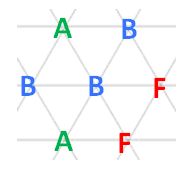
BangorDIVERSE: Forest Diversity and Ecosystem Function
Experimental Design

 A replacement series design (with inter-tree spacing constant between treatments) was selected because of the experiments objective of being realistic in reflecting the practical realities of how forests comprising monocultures or mixtures of potential canopy tree species could be established (Jolliffe, 2000). A systematic hexagonal planting design (Aguiar et al. 2001) was used to maximise the mixing effect so that, in the three species mixture blocks, each tree was surrounded by nearest neighbours of two-con-specific individuals and one and three individuals of the other two species, respectively, resulting in each tree having six equidistant neighbours.
A replacement series design (with inter-tree spacing constant between treatments) was selected because of the experiments objective of being realistic in reflecting the practical realities of how forests comprising monocultures or mixtures of potential canopy tree species could be established (Jolliffe, 2000). A systematic hexagonal planting design (Aguiar et al. 2001) was used to maximise the mixing effect so that, in the three species mixture blocks, each tree was surrounded by nearest neighbours of two-con-specific individuals and one and three individuals of the other two species, respectively, resulting in each tree having six equidistant neighbours.
The entire experiment covers 2.36 ha, individual plots range in size from 0.01 ha to 0.16 ha, and contain between 80-160 trees dependent on mixture composition. The plots were thinned to 2,500 stems ha-1 during the winter of 2012-13 to avoid damage to the tree crowns and foliage.
References
Aguiar F.C., Ferreira M.T., Moreira I. (2001). Exotic and native vegetation establishment following channelization of a western Iberian river. RegulatedRivers-Research & Management, 17, 509–526.
Jolliffe PA. (2000). The replacement series. Journal of Ecology, 88, 371-385.

